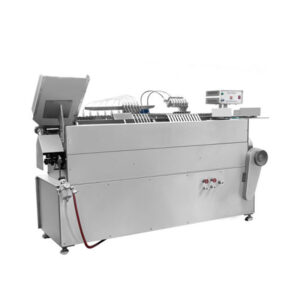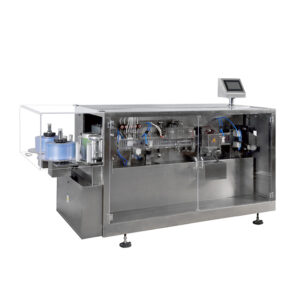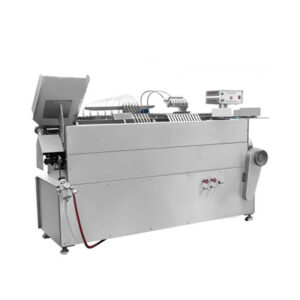Description
| Parameter | Description |
|---|---|
| Production Capacity | X ampoules per hour |
| Ampoule Sizes Supported | Range: Y ml to Z ml |
| Filling Accuracy | +/- A% |
| Sealing Method | B |
| Sterilization Method | C |
| Material of Construction | D |
| Power Requirements | Voltage: E VAC, Frequency: F Hz, Power: G kW |
| Air Pressure Requirement | H psi |
| Control System | Type: I |
| Dimensions | Length: J mm, Width: K mm, Height: L mm |
| Weight | M kg |
Types of Ampoule Production Lines
Ampoule production lines have been broadly divided into two categories:
Automatic Ampoule Production Lines: These types of lines are entirely automated since they incorporate high-tech machinery as well as robots which help in carrying out various stages involved when manufacturing an ampoule. High output rates characterize automatic type while precision and efficiency further define them.
Semi-Automatic Ampoule Production Lines: In this case, some parts are mechanized while others need personal attention. Again smaller scales may be more flexible in terms of this kind of production line’s design.
Working Processes
These working processes typically include several stages when it comes to ampoule production:
Glass Melting and Forming: The glass used in the melting process is put inside a furnace with high temperature being used. Then it will be molded by a forming machine according to the shape required for an ampule.
Ampoule Sealing: After glass shaping each ampule gets filled with drug content or solution then its neck ends are heated before sealing so that there wouldn’t be any air entry or contaminations.
Sterilization: The sealed ampules can indeed be subjected to sterilization methods such as steam or gamma radiation; hence maintaining them in their original condition before reaching customers.
Labelling and Packaging: After undergoing the sterilization process the labelling details like drug name dosage amount etc must be put up because they are ready for distribution after being packaged in cartons or boxes.
Applications and Functions
Ampoules have multiple applications across different industries which include pharmaceuticals, healthcare, and cosmetics. Some of the main functions and applications of ampoules are:
Medicinal use: Ampoules are used as containers for injectable medical drugs like vaccines, antibiotics, and insulin. They can preserve drugs in their most sterile state before they reach patients.
Cosmetic Industry: The small size as well as air-tight seal makes ampules effective ingredients in packaging serums, and essential oils among other skincare products.
Laboratory and Research: These glass-sealed ampules contain highly sensitive chemicals, reagents, or even biological samples hence used for keeping some of them. It protects against contamination or degradation, unlike open bottles which will not help to prevent these things from happening inside them.
Emergency Medicine: In cases where medication needs to be administered quickly during emergencies, ampoules are normally employed. This is because they come in single doses which are easy to break to administer medicine within a very short period while also accurately determining the amount required on time.
Benefits of Ampoule Production Lines
Adoption of ampule production lines has several advantages to manufacturers, healthcare providers as well as consumers:
Improved Product Quality: Consistency and precision in manufacturing ampules by automated production lines lead to better quality products with improved reliability.
Increased Efficiency: By streamlining the manufacturing process through an ampule production line labor force is reduced thus cutting down costs and saving time associated with production resulting in high productivity.
Enhanced Safety and Sterility: Pharmaceutical Products Hermetically Sealed Ampoules, Free from Contamination and Sterile to Secure Safety of Patients
Extended Shelf Life: Light, Moisture and Air-Resistance Characteristics of Ampoules Manufacturers make sure that the enclosed drugs or formulations last long by making them resistant to environmental factors like moisture, light, and air.
Customization and Flexibility: With modern production lines; manufacturers can produce ampoules made out of different materials as well as those having varying sizes or shapes depending on the prevailing market needs.
Future Trends in Ampoule Production
In the future, ampoule manufacturing will be driven by automation trends aimed at improving efficiency, sustainability, and quality. Some of these new directions include:
Industry 4.0 Technologies Integration: The review has integrated Industry 4.0 Technologies some of which are Artificial Intelligence (AI), and Internet of Things (IoT) among others to maximize process efficiency in terms of time taken as well as monitoring how equipment performs.
Green Manufacturing Practices: To reduce energy consumption while minimizing waste generation more sustainable materials are being explored for ampule production.
3D Printing In Sourcing Ampoules: Additive Manufacturing processes like 3D printing have the potential to revolutionize ampule production through fast prototyping customization and material savings.
Robotics And Automation: However, there is an expectation that robotics and automation will continue expanding into large-scale ampule production hence enhancing accuracy levels along with reducing human involvement.
Advanced Packaging Solutions: Innovations such as smart packaging or radio-frequency identification tagging systems will help improve serialization & traceability which is important for this particular product type called “ampules.”
Maintenance and Training
For smooth running and a longer life span in the operation of their lines, effective maintenance together with training programs need to be implemented.
Key aspects of maintenance and training include
Scheduled Equipment Inspections: Regular inspection visits should be planned to check out any possible occurrence of issues or problems with the plant machinery.
Calibration and Servicing: Equipment and instruments on the line have to be maintained accurately by frequent calibration and servicing.
Operator Training Programs: Line operators’ comprehensive training programs on how to run machines, safety precautions, as well as troubleshooting techniques, should be undertaken.
Continuous Improvement Initiatives: Manufacturers are advised to implement an approach that is continuously being improved where operators’ feedback is taken into consideration while maintenance personnel can identify areas where processes may be optimized for efficiency purposes.
Documentation And Record Keeping: This will ensure that all activities carried out about maintaining regulatory compliance and traceability of equipment performance are well recorded.
Most Commonly Asked Questions
- What is an ampoule production line?
An ampoule production line is a manufacturing system designed for the mass production of small, sealed vials typically used for containing pharmaceuticals or cosmetics in liquid form.
- How does an ampoule production line work?
Ampoules are produced through successive stages like glass tubing preparation, forming, filling, sealing, labeling, and packaging. Machinery has been incorporated to facilitate quality production and high-speed process performance features within
- What types of ampoules can be produced on an ampoule production line?
These lines therefore manufacture different kinds of ampoules including those made of clear or amber glass; further, their sizes along with shapes tend to change based on requirements stipulated for such pharmaceuticals or cosmetic products.
- What are the key components of an ampoule production line?
Therefore; there are various process steps which include performing surgical cuts using glass tube cutting machines until they turn into proper sizes with some even ending up before filing but always start from scratch since they lack anything else other than just raw materials.
- What are the ampoule production line quality control measures?
The quality control measures include visual inspection systems, automated rejection of defective ampoules, weight verification systems for filling accuracy, and seal integrity testing in addition to adherence to regulatory standards.
- Why choose an ampoule production line?
Advantages often cited include high production efficiency, precise dosage control, hermetic sealing to maintain product integrity, reduced risk of contamination, and compliance with regulatory standards.
- How can the effectiveness of an ampoule production line be improved?
Efficiency may be improved through process automation, machinery’s regular maintenance, keeping a close eye on certain parameters during manufacturing, employee training as well as embracing lean manufacturing principles.
- What are the main issues associated with ampoule production lines?
Commonly, these challenges encompass glass breakage during forming, maintaining sterile conditions, ensuring accurate filling without air bubbles or excessive wastage of products, and complying with extremely stringent regulatory requirements.
- What safety precautions should I take when operating an ampoule production line?
Such considerations range from proper staff training to the use of protective gear as well as routine equipment servicing besides following prescribed procedures while handling glass and chemicals and emergency response planning.
- How can I know the best ampoule production line for my needs?
This might include considering the manufacturer’s reputation (ref), production capacity (ref), cost-effectiveness in the long term (ref), flexibility in dealing with different sizes and types of ampoules (ref), manufacturer’s customer service (ref).





Reviews
There are no reviews yet.